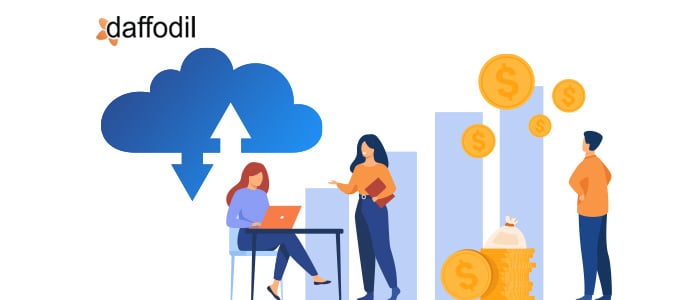
Digital transformation and cloud migration were the survival doors for businesses to escape the uncertainty of the COVID-19 pandemic.
Online availability. Remote accessibility. Cost-saving. Maintenance ease! These were some of the highlighted reasons to move from on-premise infrastructure to the cloud. While there are several benefits of migrating to the cloud, it could be the other way around if the best practices are not in place.
For example, the cloud cost needs to be optimized for maximum profits. It is important to continuously analyze the infrastructure and tools consumed by code, along with the licensing fees paid to third parties.
“Gartner predicts that enterprises that lack cost optimization processes will average 40% overspend in the public cloud.”
To measure which service proves profitable according to business or code functionality, FinOps has a significant role to play. FinOps (Finance + Operations) is a framework that prescribes the best practices for optimizing the cloud cost. This may include (but is not limited to), tracking and optimizing trials, forecasting costs, vendor negotiation, adopting & managing multi-cloud strategy, etc.
The goal is to prioritize optimization of cloud cost to ensure maximum value for minimal spending. But, to make this possible, there are a set of best practices that are followed by FinOps Analysts. In the latter segment, we will discuss a few FinOps practices that can be adopted for cloud finance management.
Cloud FinOps: Best Practices (from the desk of a FinOps expert)
1. Have a Strategic Migration Plan
If the IT team has decided to move the on-premise infrastructure to the cloud, then that’s the best time to think about FinOps. The reason is, it helps to create a roadmap for migration that plans for scaling, integrations, compliances, backups, pricing policy, budget, etc. In addition to this, having a plan in advance helps the FinOps analysts to take advantage of the available opportunities such as free trials or bulk user pricing.
The benefit of auto-scaling with cloud versus on-premise infrastructure is a big cost savior. With less idea of how a business would scale in the future, the IT team usually invests in an infrastructure of large size, which shoots up the overall cloud cost.
Cloud infrastructure can be scaled as the requirement strikes, which saves the CapEx and OpEx costs to a great extent. Therefore, if the plan is to move to the cloud, have a FinOps framework that will help to get more from a cloud platform.
2. Improve Cloud Visibility within Organization
To control the cloud cost, it is important that the teams within an organization are informed about how and what cloud services are being used, tools and licenses being utilized, etc. By doing so, the teams can take accountability for keeping the IT teams informed about any services/tool that needs to be discontinued.
Not having visibility about how the resources are being used can lead to their wastage and highly impact the cloud cost. The FinOps analysts ensure that the cloud usage information reaches the team members so that they have a role in optimizing the services.
3. Audit Cost & Infrastructure to Reduce Waste
For optimizing cost, it is important to keep a track of upfront and ongoing expenses. A FinOps analyst keeps a record of the total cost of ownership (TCO), Return on Investment (ROI), and performs regular audits of the resources to forecast the future costs. For tracking the cost, the managed services provider offers their proprietary tools (like AWS Cost Explorer by Amazon). However, there are third-party tools as well that help in comprehensive tracking of the resources utilized.
In addition to analyzing the cost, the FinOps analysts assess how the resources are procured. For example, if an application requires frequent start/stop, then it is good to opt for a pay-per-second (GCP) pricing policy instead of a pay-per-minute policy (AWS). Here are some similar tips on how to optimally use a cloud infrastructure. Adopting such practices helps in optimizing the cloud cost.
Implementing FinOps in your Organization
FinOps is a must-have practice for an organization that hosts its infrastructure on cloud or multi-cloud platforms. To get started, a FinOps analyst can be aligned with an existing IT or CloudOps team to take care of the cloud financials.
A cloud FinOps analyst performs the following tasks for an account:
- Monitor cloud consumption, detect, investigate anomalies and unplanned spikes for a cloud account.
- Discover and share cloud cost optimization opportunities, forecast cloud consumption, chargebacks, showback, etc.
- Work directly with technical teams, business management, market units and translate financial insights into actionable recommendations.
- Implement an automated resource optimization model and help business stakeholders in understanding the cloud spend.
- Maintain reports ad KPIs that highlight the usage statistics of resources across the multi-cloud environment.
An organization can either hire or outsource FinOps analysts to perform cloud cost optimization. At Daffodil, we have dedicated resources performing this job for our enterprise-level clients. To know more about our FinOps as a Service, connect with our cloud experts through a 30-minute free consultation.



